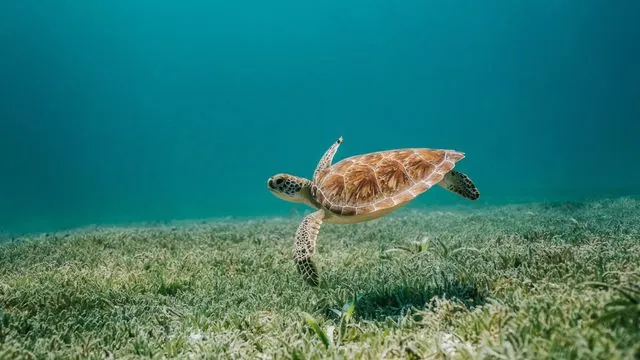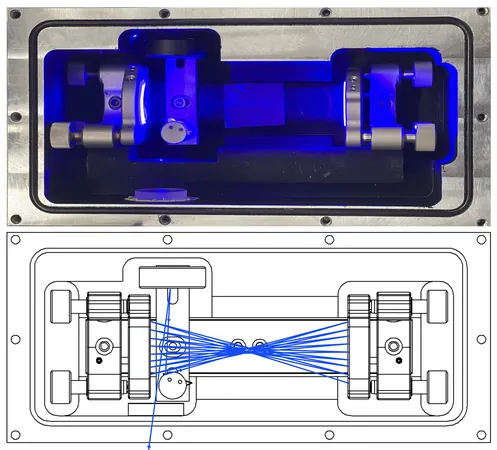
The Ingenious Design of Sea Turtle Shells: Armor Meets Agility in the Ocean
2025-04-08
Author: Jia
Introduction
When we envision sea turtles gliding through the vast oceans, we often think of them as armored guardians, their robust shells shielding them from formidable predators like sharks. However, these shells are not merely about defense—they embody a masterful engineering feat that enhances both speed and efficiency, allowing these majestic creatures to thrive in their aquatic environment.
Structure of Sea Turtle Shells
A sea turtle's constitution is divided into two primary sections: the carapace (the top shell) and the plastron (the lower shell), both encased in scutes—durable keratin plates that are firmly adhered to the bone structure. This intricate design forms a strong yet lightweight shell, featuring a dense outer layer and a spongy core that provides critical support for the turtle’s muscles, nerves, and vital organs while allowing buoyancy for effortless swimming.
Research Overview
While a wealth of research has been conducted on the shells of terrestrial turtles and tortoises, the shells of marine turtles have not received the same scholarly attention. To close this knowledge gap, researchers from Florida Atlantic University undertook an in-depth investigation of the biomechanical properties of the carapaces of three prevalent North Atlantic sea turtle species: green turtles (Chelonia mydas), loggerheads (Caretta caretta), and Kemp's ridleys (Lepidochelys kempii).
Findings of the Study
Their groundbreaking study, published in the Journal of Experimental Biology, employed advanced compression tests and statistical models to evaluate the shells' toughness, stiffness, and strength across various life stages. Astonishingly, they discovered that these adaptations play a critical role in balancing biomechanical trade-offs. The turtles’ shells possess lower stiffness combined with high flexibility, enabling them to evade predators and adapt to environmental stressors while efficiently navigating through water.
Species-Specific Characteristics
Each species exhibits distinct characteristics in shell composition and response to stress. Green turtles are noted for having the toughest and stiffest shells, with denser, more resilient bone structures. Conversely, loggerheads feature a more flexible and porous design, which allows for greater compliance under pressure—a trait that likely aids them in open ocean environments where predation risk is lower.
Maturation and Shell Robustness
Interestingly, the research also revealed that as green turtles and Kemp's ridleys mature, their shells become increasingly robust, granting enhanced protection against threats during their later life stages. This is particularly pronounced in Kemp's ridleys, which experience a more rapid increase in shell stiffness as they transition to foraging in risk-laden coastal waters.
Evolutionary Insights
“What stands out is how these turtles’ shells evolve concurrently with their growth, increasing in strength to offer better defense as they mature,” remarked Ivana J. Lezcano, the lead author and a doctoral student within the FAU Department of Biological Sciences. “The differences in stiffness among species could be closely linked to their evolutionary paths and the environments they occupy.”
Loggerheads' Shell Stability
Loggerheads, in contrast, maintain relatively stable shell stiffness throughout their lives, which may explain their preference for remaining in open waters until they are larger and more capable of withstanding risks associated with coastal habitats.
Shared Biomechanical Features
Moreover, the findings indicated that the biomechanics of marine turtle shells share similarities with those of terrestrial turtles, emphasizing the fundamental structural similarities despite their vastly different lifestyles. The internal porous structure of their shells is pivotal, lending them a perfect blend of stiffness and toughness that shields against predator attacks.
Research Implications
“The compliance of adult sea turtle shells is surprising, especially when compared to their land counterparts,” explained Jeanette Wyneken, a co-author of the study and professor of biological sciences. “What's fascinating is that their shells gain strength over time without becoming inflexible. This flexibility allows them to navigate the often harsh underwater conditions effectively.”
Conclusion
The implications of this study extend far beyond mere academic curiosity. Understanding the sophisticated design of sea turtle shells not only sheds light on the evolutionary success of these ancient marine reptiles but also underscores the delicate balance of adaptability and resilience that has allowed them to thrive in oceanic environments for millions of years.
Final Thoughts
In summary, the intricate versatility of sea turtle shells—highlighted by their blend of strength and flexibility—offers a compelling example of nature’s capabilities to sculpt species for survival in complex environments. With ongoing research, we continue to unveil the remarkable adaptations that support the enduring success of these iconic ocean dwellers.



 Brasil (PT)
Brasil (PT)
 Canada (EN)
Canada (EN)
 Chile (ES)
Chile (ES)
 Česko (CS)
Česko (CS)
 대한민국 (KO)
대한민국 (KO)
 España (ES)
España (ES)
 France (FR)
France (FR)
 Hong Kong (EN)
Hong Kong (EN)
 Italia (IT)
Italia (IT)
 日本 (JA)
日本 (JA)
 Magyarország (HU)
Magyarország (HU)
 Norge (NO)
Norge (NO)
 Polska (PL)
Polska (PL)
 Schweiz (DE)
Schweiz (DE)
 Singapore (EN)
Singapore (EN)
 Sverige (SV)
Sverige (SV)
 Suomi (FI)
Suomi (FI)
 Türkiye (TR)
Türkiye (TR)
 الإمارات العربية المتحدة (AR)
الإمارات العربية المتحدة (AR)